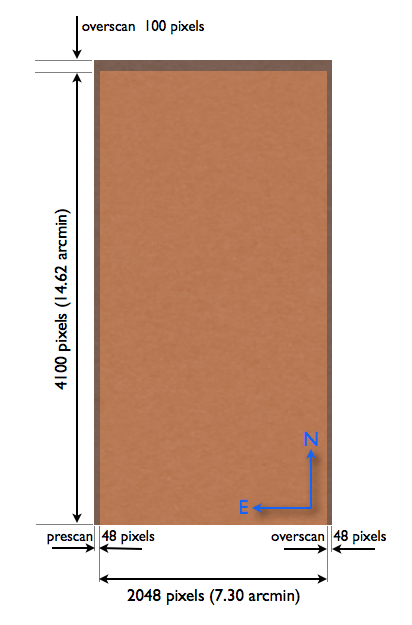 mirror sites:
PL (internal link)
HQ
[?]
mirror sites:
PL (internal link)
HQ
[?]
Quality Control and
Data Processing
|
OMEGACAM: Bias
BIAS frames are taken on a daily basis during normal VST/OmegaCAM operations. They are usually obtained during day-time calibration and consist of 10, zero second, closed shutter, raw bias exposures. From this, the pipeline creates two output frames from its bias recipe (omega_mbias): a master bias (OC_MBIA_<date>_1_1_normal_normal.fits) and a hot pixel mask (OC_MHPM_<date>_1_1_normal_normal.fits). The master bias frame is created from the 10 input raw bias frames averaged together with a 5sigma rejection of outliers (where sigma is defined from the dispersion of each pixel through the 10 input frames). The master bias is used for all subsequent processing and the hot pixel map is used in the flat field recipe in order to create a master bad pixel map consisting of both the hot and cold pixels.
 BIAS level
BIAS level
The master bias frames from detectors ESO_CCD_68 and 90 have a pronounced central ridge. This is stable and can be well subtracted. Therefore, these features are tolerated, but can create a larger number of hot pixels when compared to other detectors.
The median bias level averaged over all CCDs is plotted in box 1 and of individual CCDs in box2 of the trending plot. Box 3 shows scores for each CCD. The mean level of the first and second raw bias frame for selected detectors 82, 81, and 83 (in ADU) is plotted here .
The median bias level is tightly scored, with static thresholds following the median average of the current period. The only requirement on the bias level is stability on the calibration timescale.
The median level and the standard deviation of the master bias frame are calculated for each extension (ADU).  Hot pixels
Hot pixels
The number of hot pixels is detected in the master bias frame for each extension. The hot pixels are derived by thresholding. First the mean (Mean) and the standard deviation (Stdev) is derived on the master_BIAS. Then all pixels exceeding "Mean" + "rej-sigma" * "Stdev" are marked as hot pixels. "rej-sigma" is a recipe parameter with the default values: --rej-sigma : Rejection threshold for outlying pixels in Hot Pixels Map. [5.0] The number of hot pixels detected in the bias pipeline product frame HOT_PIXELS_MAP is trended for individual CCDs, as well as averaged over all 32 detectors.
The number of hot pixels averaged over all CCDs is loosely scored, with static thresholds following the median average of the current period. The only requirement is stability of the number on the calibration timescale.
The number of hot pixels found in each individual detector (detectors: ESO_CCD_68, ESO_CCD_82, ESO_CCD_84, and ESO_CCD_90 consistently show very high values). |
||||||||||||||||||||||||||||||||||||||||||||||||||||||||||||||||||||||||||||||||||||||||||||||||||||||||||||||||||||||||||||||||||||||||||||||||||||||||||||||||||||||||||||||||||||||||||||||||||||||||||||||||||||||||||||||||||||||||||||||||||||||||||||||||||||||||||||||||||||||||||||||||||||||||||||||||||||||||||||||||||||||||||||||||||||||||||||||||||||||||||||||||||||||||||||||||||||||||||||||||||||||||||||||||||||||||||||||||||||
| |
|||||||||||||||||||||||||||||||||||||||||||||||||||||||||||||||||||||||||||||||||||||||||||||||||||||||||||||||||||||||||||||||||||||||||||||||||||||||||||||||||||||||||||||||||||||||||||||||||||||||||||||||||||||||||||||||||||||||||||||||||||||||||||||||||||||||||||||||||||||||||||||||||||||||||||||||||||||||||||||||||||||||||||||||||||||||||||||||||||||||||||||||||||||||||||||||||||||||||||||||||||||||||||||||||||||||||||||||||||||
 |
|
||||||||||||||||||||||||||||||||||||||||||||||||||||||||||||||||||||||||||||||||||||||||||||||||||||||||||||||||||||||||||||||||||||||||||||||||||||||||||||||||||||||||||||||||||||||||||||||||||||||||||||||||||||||||||||||||||||||||||||||||||||||||||||||||||||||||||||||||||||||||||||||||||||||||||||||||||||||||||||||||||||||||||||||||||||||||||||||||||||||||||||||||||||||||||||||||||||||||||||||||||||||||||||||||||||||||||||||||||||

